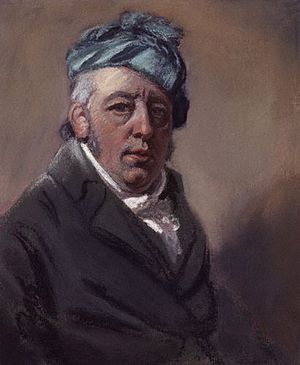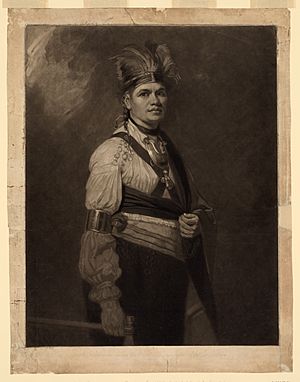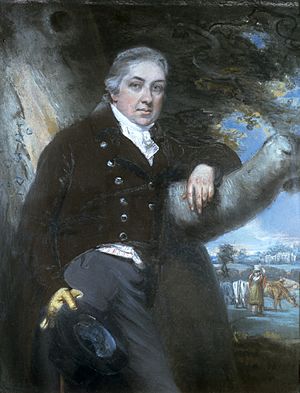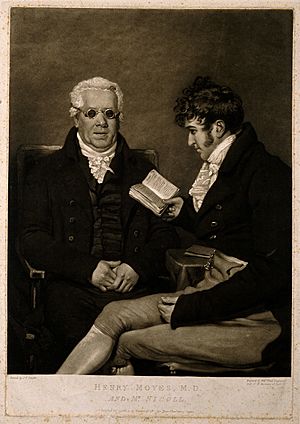John Raphael Smith facts for kids
Quick facts for kids
John Raphael Smith
|
|
|---|---|
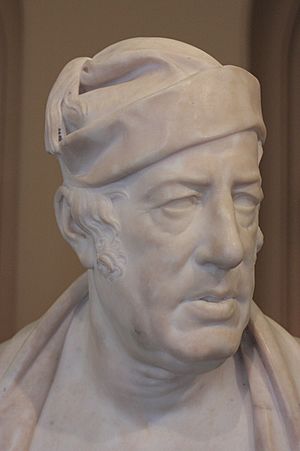
Sculpture by Sir Francis Chantrey in the V&A
|
|
| Born | 1751 |
| Died | 2 March 1812 |
| Occupation | painter and mezzotint engraver |
John Raphael Smith (born 1751 – died 2 March 1812) was a talented British painter and mezzotint engraver. A mezzotint is a special type of printmaking that creates images with soft, rich tones. John Raphael Smith was the son of Thomas Smith, a famous landscape painter from Derby. His own son, John Rubens Smith, also became a painter and later moved to the United States.
Contents
Early Life and Career
John Raphael Smith was baptized at St Alkmund's Church in Derby on May 25, 1751. He was named after the famous Renaissance artist, Raphael. His father was a respected citizen of Derby. After a short time at Derby School, John Raphael became an apprentice to a linen-draper in the city. His older brother, Thomas Corregio Smith (1743–1811), was also a painter.
In 1767, John Raphael Smith moved to London. He wanted to start a print-making business. He also earned money by creating small portraits called miniatures. Soon after arriving, he met Ann Darlow. They married on May 20, 1768.
Becoming a Master Engraver
Smith soon focused on engraving. His first big success was a mezzotint of Pascal Poali, based on a painting by Henry Benbridge. This helped launch his career. He then created a very popular print called Public Ledger. Other famous mezzotints followed, including Edwin the Minstrel (a portrait of Thomas Haden) after a painting by Wright of Derby. He also made Mercury Inventing the Lyre after Barry.
John Raphael Smith created about forty mezzotints based on works by Sir Joshua Reynolds. Many of these are considered masterpieces of mezzotint art. One notable print was of Mr Banks, after a portrait by the artist Benjamin West. This print was shown at the Society of Artists in 1773.
In 1778, Smith was asked to make a mezzotint engraving of a painting called The Captive by Joseph Wright of Derby. Only twenty copies of this rare engraving were made before the printing plate was destroyed. One of these special engravings is kept in Smith's hometown at the Derby Museum and Art Gallery.
Smith's mezzotints of Mrs Carnac (1778) and Lieutenant-Colonel Banastre Tarleton (1782) are great examples of his work. They show famous people from the Georgian era. Tarleton was a well-known cavalry officer during the American campaign. Smith also worked as a print-dealer and publisher. He had a strong sense of drama, which showed in his art. One example is his mezzotint Promenade at Carlisle House, shown in 1782.
Royal Recognition and Later Work
Smith's mezzotints of George Romney's portrait of The Children of Earl Gower and Thomas Gainsborough's George, Prince of Wales helped him gain royal attention. In 1784, he was appointed as the Mezzotint Engraver to the Prince of Wales. More successful works followed, like The Weird Sisters after Henry Fuseli (1785), and A Widow of an Indian Chief (1789), after Joseph Wright of Derby.
He was a good friend of George Morland, whose paintings of everyday life were often turned into mezzotints by Smith. Smith frequently showed his art at the Society of Artists. He also exhibited oil paintings, chalk drawings, and pastels at the Royal Academy in Piccadilly. For example, his mezzotint of The Credulous Lady and Astrologer was shown in 1785. In 1803, he had a special exhibition of his oil paintings. Overall, Smith created over 400 mezzotint and stipple works. These included about 120 pieces showing scenes from ordinary life or satirical subjects.
Influencing Other Artists
From 1781, Smith became a publisher in London. One of his clients was the famous writer and artist William Blake. Smith was also a great teacher and mentor. He shared his printing plates with many other London printers. Many important artists learned from him, including J. M. W. Turner, Charles H. Hodges, William Ward, Thomas Girtin, and James Ward. Other students included William Hilton, Christiaan Josi, Samuel William Reynolds, and Peter de Wint.
As a mezzotint engraver, John Raphael Smith was one of the best. His prints are delicate, well-drawn, and show great color. Among his pastel and crayon portraits, one of the best is of Fox, a leader of the Whig political party. This portrait was shown at the Royal Academy in 1802. He also painted portraits of other important political figures like Horne Tooke and Sir Francis Burdett. Smith knew a lot about art history and was known for being a brilliant conversationalist.
Later Life and Legacy
John Raphael Smith had two more children with Hannah Croome (1757–1829), who survived him. In 1793, he opened the Morland Gallery in King Street, Covent Garden. Here, he published catalogs of his prints. By 1798, he had listed over 302 publications. He also painted subject-pictures like The Unsuspecting Maid and The Moralist, which he exhibited at the Royal Academy from 1779 to 1790.
When his print-selling business slowed down, he traveled through the north and midland parts of England. He eventually settled in Doncaster. Smith was the one who first recognized the artistic talent of the sculptor Sir Francis Legatt Chantrey. Smith gave Chantrey painting lessons. Later, Chantrey created a sculpture of Smith to show his appreciation. This sculpture is now in the Victoria and Albert Museum in London. Smith also painted a portrait of Chantrey.
From 1808, Smith began to lose his hearing. He continued to travel widely through the North of England from his home in Doncaster. He passed away at his home there and was buried in the local churchyard.
Selected Portraits and Mezzotints
- King George III (1760)
- John Stuart, 1st Marquess of Bute (1760)
- Hon Mrs Stanhope
- Thomas King, English actor (1772)
- Mr Banks (1773)
- Chryses invoking the Vengeance of Apollo (1774)
- Augustus Montague Toplady (1777)
- Carlini, Bartolozzi and Cipriani (1778)
- Mrs Elizabeth Carnac (1778)
- Miss Brown (1778)
- Joseph Tayadaneega, the Brant, the Great Captain of the Six Nations (1779)
- Self-Portrait (1782)
- Lieutenant-colonel Banastre Tarleton (1782)
- The Weird Sisters (1785)
- Rev Charles Alcock (1785)
- The Widow's Tale
- Self-Portrait (1785-7)
- Shepherdess (1787)
- William Bentinck, Duke of Portland and Lord Edward Bentinck (1788)
- The Moralist (facsimile after JRS, 1900)
- The Widow of an Indian Chief (1789)
- Edward Heardson, cook for the Ad Libitum Society (1789)
- 'What You Will' (c1790)
- George Morland (1792)
- His Royal Highness, George, Prince of Wales (1792)
- Sir William Musgrave, 6th baronet
- Miss Chambers
- Gypsy encampment
- Edward Jenner (1800)
- Lady in a Straw Hat
- Hon Douglas Kinnaird
- Sir Francis Burdett, Bt
- Sir Benjamin, Count Rumford (c1800)
- Thomas Morton (1803)
- Thomas Hartley, Lord Mayor of York (1803)
- Colonel and Mrs Thornton (1806)
- Lieut William Collingwood, Northumberland Militia (1809)
- John Bigland, Doncaster schoolmaster (1810)
- John Horne Tooke (1811)
- Major General Benjamin Lincoln, President of the Cincinnati (1811)
- Sir Francis Leggatt Chantrey (1818)


